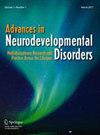Fluctuations of the Center of Pressure in Autism Spectrum Disorder
Abstract
Abstract
Objectives
The static standing position of autism spectrum disorder (ASD) is unstable. However, the cause has not been clarified. We will investigate the fluctuation of center of pressure (COP) by detrended fluctuation analysis (DFA) and contribute to the elucidation of the cause in the future.
Method
We investigated the characteristics of fluctuations in the COP in 16 individuals with ASD and 13 individuals with typical development (TD). All participants stood on a Wii Balance Board for 70 s during which time we obtained COP data at 100 Hz. The eyes-open and eyes-closed conditions were performed once each. We obtained the locus length, total locus length, outer peripheral area, and the mean value and standard deviation of the coordinate position, and also calculated the mean value, standard deviation, coefficient variability, and alpha index of velocity from the acquired data, which we used as evaluation indices.
Results
The locus lengths in the mediolateral and anteroposterior directions and the total length, as well as the outer peripheral area of the COP, found no significant differences between the groups. The alpha index showing the strength of long-term correlations of the standing position by DFA of moving distance per 100 Hz in the ASD group was significantly larger than that in the TD group (p = .011) in the anteroposterior direction under the eyes-closed condition.
Conclusions
Postural sway in the ASD group did not differ from TD but was maintained from a long-term perspective.


 求助内容:
求助内容: 应助结果提醒方式:
应助结果提醒方式:


